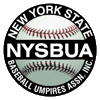By NFHS on November 22, 2016
DEFINING THE LEGALITY AND LOCATION OF SLIDING (2-32-2C)
The act of sliding is optional. However, if a base runner decides to slide, then he is held to certain criteria to ensure that neither the offensive nor defensive player is intentionally injured. There are six criteria that constitutes an illegal slide. Due to the physical design of home plate, it is not possible for a runner who chooses to slide to stop at or on top of home plate while running as fast as possible to score. In order to stop at or on home plate, the runner would have to run slower or begin his slide earlier, which would give the defense an advantage. This change allows the runner’s momentum to carry him through home plate in a straight line (baseline extended). He is still held to the other elements of Rule 2-32-2 and malicious contact as it relates to interference with the catcher. The catcher is protected because he has choices of locations where he can position himself to avoid contact.
DETERMINING WHEN A COACH-ASSISTED RUNNER IS CALLED OUT (3-2-2 Penalty)
Simply stated, the coach-assisted base runner is called out immediately without deference to other batter-runner or runners and play continues.
CLARIFYING THE PENALTY ADMINISTRATION TO COACHES AND PLAYERS (3-3-1 Penalty)
Coaches and officials are equally responsible to provide an ideal learning environment for the students who play baseball. That learning environment is severely disrupted if the adults show a lack of respect for each other’s position and role in the contest. The coach has the responsibility to coach and teach his players about basic and complicated skills of baseball and important life lessons. The game official has the obligation to administer the rules of the game and to judiciously address any coach’s or player’s behavior that is not consistent with those rules.
As he (umpire) administers any penalty resulting in a warning, restriction to the bench/dugout or ejection, his decision should be in response to the actions of the offending coach and player. The coach needs to understand that his behavior will dictate which level of discipline is applied. Utilizing a three-step process, the umpire is given the opportunity to de-escalate any situation that might arise during the course of the game.
This clarification of last year’s rule provides an additional “teachable moment” element to the current rule. Umpires are given clear procedures for dealing with minor unsportsmanlike behavior while at the same time promoting the practice of keeping coaches and players “in the game” and minimizing ejections. Officials are encouraged to clearly communicate their warnings and restrictions when possible to the coaches prior to ejection. The coaches also need to recognize when those warnings and restrictions are being issued so they can modify their behavior and continue to teach their players. When the adults are acting in a professional and respectful manner, the young people will be the ultimate winners regardless of the score of the game.
MODIFICATION OF THE PITCHING RESTRICTION POLICY (6-2-6)
After years of research and thoughtful discussion on minimizing risk for the position of pitcher, it has been determined that modifying the pitching restriction rule to reflect that the policy should be based on the number of pitches thrown is a better indication of overuse and repetition than the current method of innings pitched during a contest.
BASERUNNING AWARDS FOR UMPIRE HINDERING THE CATCHER’S ABILITY TO MAKE A DEFENSIVE PLAY (8-3-6)
This rule changes provides rules support that was missing from the rules book.
SUBSEQUENT RULE SUPPORTING THE COACH-ASSISTED RUNNER (8-4-2s)
This rule supports the action taken in Rule 3-2-2 Penalty regarding coaches’ conduct with assisting a base runner.

